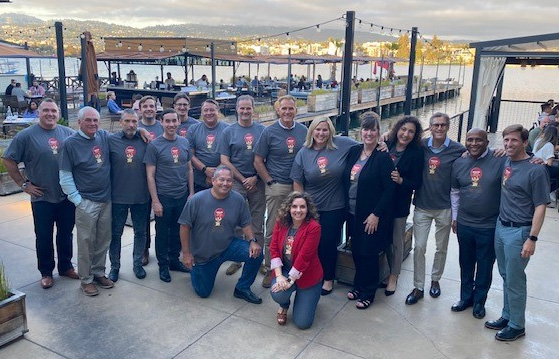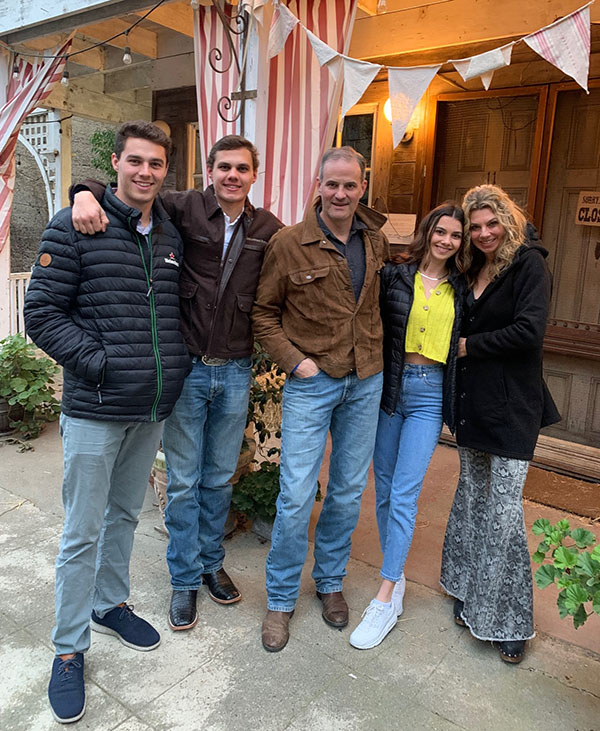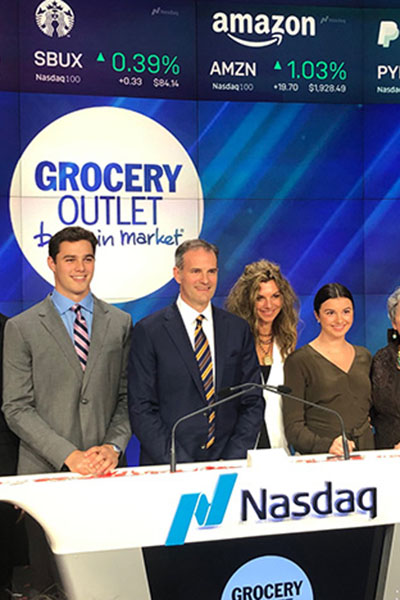The Big Cheese of Grocery Outlet
From the Record, Summer 2022
By Alexandra Evans
What began in 1993 as an internship with family-owned Grocery Outlet became the preservation of a family legacy with Eric Lindberg '93 at the helm.
In May of 1993, after the last of the tassels had been turned and the final bottle of champagne had been popped, Eric Lindberg '93 and his then-girlfriend Megan Read (Sweet Briar College '91) hopped into Eric’s car and headed west. Their destination was Megan’s home state of California. Their reason was, why not?
“I didn’t know what I wanted to do after graduating,” Lindberg says. “So I said to Megan, ‘Let’s just drive across country and end up in California. Maybe we’ll stay out there for a few months and figure out what we want to do.’” Little did Lindberg know that was just the start of their story.
Finding His Cup of Tea
In 1946, Megan’s grandfather Jim Read combined a supply of excess foodstuffs from World War II and excess real estate in the form of shuttered storefronts in downtown San Francisco to open his first store, named Cannery Sales. Cannery Sales became Canned Foods in 1970 and began selling closeout, factory-second, and reduced-price products in addition to the deeply discounted food items for which it had become known.
By 1993, Canned Foods had expanded to nearly 100 locations, had been rebranded to become Grocery Outlet, and was now being run by Megan’s father, Peter, and uncle, Steve. For a freshly graduated economics major fascinated with business, this was a great place for Lindberg to get his feet wet in the real world. He took an internship with Grocery Outlet and began gaining exposure to all of the company’s departments.
“By the end of that summer, we were homesick for homecoming and football games and tailgating, so we headed back to the East Coast for a couple of years,” Lindberg says. After tying the knot, the newlyweds had the opportunity to move to London, where Lindberg worked in IT and Megan worked in retail. Unfortunately, just a year and a half after hopping the pond, Megan’s mother fell ill, and the couple felt the call to return to California to be closer to family.
With this return, Lindberg needed a job, and Grocery Outlet was once again a natural fit. “My father-in-law said if I was really serious about a future with the company, though, I needed to get hands-on experience in a store and absorb the culture. So he sent me to the Oakland store for a year as a manager to get that experience.” Lindberg admits that this experience was exactly what he needed to be successful long-term with Grocery Outlet.
“My father-in-law was always really generous to me and said, ‘I’ll give you an opportunity if you’re capable and interested.’ And I kept answering the call to do more,” Lindberg says. “I had no idea I’d be here forever.”
Grocery Outlet’s Bread and Butter
Twenty-eight years later, he is indeed still there, and now he’s the CEO. “I love that we get to do something that matters every day,” Lindberg says. “The virtue and the nature of the business has always been about creating opportunities for underserved communities.” Between its focus on ensuring that inner-city neighborhoods have access to high-quality, low-cost food; its Independence from Hunger campaign that has raised $17 million; a commitment to sustainability and eco-friendly operations; and a unique approach to opening new locations, it’s clear that Grocery Outlet keeps customer and community at the center of its mission.
The first line of defense to ensuring that the mission-focus remains this way is the owner-operator model for which Grocery Outlet has become known. The 420—and counting—Grocery Outlet Bargain Market locations throughout eight states are primarily owned by community partners. “Through our operator license agreement, we give the store operators access to all the tools of the trade: logistics, distribution, purchasing, software, etc. Then they hire locally and pay the local cost of running the business, and Grocery Outlet splits the gross profit margins 50/50 with the operator,” Lindberg explains. “We do the things that a single operator running a business on their own could never do at scale. And in turn the operators do something that we could never do at scale by operating in a way that truly benefits their local community.” 
“We take people who have worked in the business either at our stores or in the industry and give them an opportunity to own a store,” Lindberg continues. “A few things happen when you give someone an opportunity like this. They plant roots in that community, and the store becomes a vehicle for them to give back and get involved. And when they get involved with the church or the business club or the high school, they become known as the person in that town who operates the Grocery Outlet. When those operators become really successful, amazing things happen. They become pillars in their local communities.”
The operating model allows Grocery Outlet to remain nimble and assimilate easily into the communities where it places stores, thereby taking on a unique position as a large corporation with considerable resources to operate while adding value within the community as only a small business can.
This approach leads to big success for the local store operators and the company and has earned Grocery Outlet high retention, with operators staying 10 to 20 years in their stores, which is unique in an industry that experiences exceptionally high turnover. Part of the reason for this may lie in the fact that many of Grocery Outlet’s store operators are not only already embedded in their communities but are also family teams: spouses, father-daughter, mother-son, siblings.
“We attract people who are entrepreneurial and willing to bet on themselves,” Lindberg says. “We also hire to reflect the community where a store is located. We have a lot of racial, socioeconomic, gender, and educational diversity among our operators. If they reflect the community, we’re interested in partnering with them.”
Noting that no one loves to work for the big corporation, Lindberg points out that Grocery Outlet gives the operators the opportunity to take ownership of their store and to think about driving top-line and protecting bottom-line results through innovative approaches to merchandising and marketing in order to maximize their own profits.
And this is where the community-centric focus really shines. By identifying what their community members are interested in, store operators can put their best foot forward to appeal to those interests. “One community may be really interested in wine,” Lindberg expounds. “So a store operator could focus on emphasizing that through wine tastings and clubs and basically create a business within their store that focuses on wine. Another community may want more organic options but can’t afford to go to Whole Foods. That operator can emphasize our natural, organic, specialty, healthy (NOSH) products. Basically, operators can choose to merchandise in a way that is going to be good for their community based on their instincts and intimate knowledge of their communities.”
Despite the rapid expansion of the company, Lindberg notes that they have been able to remain sustainable and create channels to reduce waste within the industry, calling Grocery Outlet “one of the greatest recyclers on earth.” Sustainability was a byproduct of Canned Foods; it is a focus of Grocery Outlet.
“We’re buying product that would normally have to go outside of the normal supply chain if we didn’t exist,” he explains. “We’re a pressure release valve for the fast-moving consumable products industry. We have created a market for products that would have otherwise ended up in a landfill or had to be exported.”
And they do it in a way that’s really efficient. Grocery Outlet owns and operates its own distribution system, including trucks. Each store—which at 13 to 14,000 square feet is fairly small—has energy management systems, heat reclaims, and LED lighting, and they recycle everything they touch. Building in sustainable practices at each step of their supply chain is not only a smart business move but also pays homage to Grocery Outlet’s humble beginnings as the canned food store.
Creating a Culture that’s Cream of the Crop

“He loves all kinds of corporate culture,” proclaims Lindberg’s profile on the Grocery Outlet website. Starting from a young age, he watched with interest as his entrepreneurial parents ran their respective businesses—his mother a tennis coach and his father a talent recruiter—and as an economics major at Hampden-Sydney, he studied the techniques, successes, and failures of an array of companies. As a self-proclaimed business junkie, Lindberg has never stopped learning about how to build a truly great business.
Believing that the magic that separates good companies from great companies is the culture that exists, Lindberg set out to identify how his colleagues created great corporate culture. Over the course of 10 years, Lindberg knocked on the doors of business leaders such as the Cathy family of Chick-fil-A, West Coast burger giant In-and-Out, the Wood family of Wawa, and the Sheetz brothers to glean advice on delivering great customer service and motivating his employees.
He has carried the advice he received during those years with him on his rise through the ranks. Following his time as manager of the Oakland store, Lindberg became director of non-foods procurement in 1996 and then vice president of purchasing in 2001. Then in 2006, Lindberg’s father- and uncle-in-law decided to step back from the business, and Lindberg and his cousin-in-law MacGregor Read were named co-CEOs. Lindberg and Read oversaw the transition of the company from family-owned to partnering with private equity firms and worked side-by-side until 2018 when Lindberg transitioned to sole CEO and Read became vice chairman.
In June of 2019, Lindberg again found himself leaning on the company’s strong foundation of community focus to withstand the intense pressure of its newest pivot: going public. “The risk and the challenge to every business going public is taking your eye off of what really matters,” he says. “We’ve always been pretty shameless about growth, but at the end of the day, our values didn’t change when we went public: the focus on the customer and value and family.”
Eating Cake, too
The story of Grocery Outlet is 76 years old—and just getting started. While he acknowledges the challenges of taking a company public, Lindberg knows that it is key to the next chapter in the Grocery Outlet story. In a new era of grocery retail, access to bigger markets and more capital will be crucial for success.
The past two years, as is the story for any business, have been challenging. But Lindberg speaks about the success and adaptability that Grocery Outlet achieved during the COVID-19 pandemic with undeniable pride. They continued growing and were able to support both their customers and their employees through an exceptionally trying period. “We never ran out of toilet paper,” he laughs.
But more than that, Grocery Outlet was able to serve its customers in tailored ways depending on their situation throughout the pandemic. For people who lost their jobs, Grocery Outlet Bargain Market was able to offer them quality, brand-name groceries and household items at deeply discounted prices. Folks who remained financially secure but were spending more time at home had access to affordable home goods to create a comfortable atmosphere and premium food stuffs to up their home-cooking game as restaurants remained closed.
Now, as the world emerges from the pandemic, Grocery Outlet is looking toward the future. Having broken into the East Coast market in 2011, Grocery Outlet is prioritizing growth throughout the mid-Atlantic Region. With a solid base of stores through Pennsylvania and New Jersey, Lindberg is looking to bring the Grocery Outlet experience to surrounding states. He acknowledges there are challenges that come along with breaking into a new region even with a product as universal as groceries. “So much of the essence of the company is a West Coast essence, so we have to learn how to operate a little differently as we expand to the East Coast,” he says, once again acknowledging that each community is unique and deserves that attention be paid to their distinct needs and culture.
In addition to diversifying its geographical market footprint, Grocery Outlet is also exploring omnichannel development to provide a seamless experience for their customers. A budding partnership with Instacart—a grocery delivery and pick-up service—signals the next phase of innovation in Grocery Outlet’s quest to offer exceptional products and customer service to a modern, conscientious consumer.
But just as their values didn’t change when they went public, neither will this next phase of growth and expansion shift the focus from what Lindberg calls the soul of the company: providing good quality food for less fortunate communities. The way he ensures this laser focus is by staying engaged with the stores and their operators—never forgetting how beneficial his boots-on-the-ground time in the Oakland store was.
Off the top of his head, Lindberg knows what stores are owned by what families. He’s spent time with each of these families, getting to know their dreams, backgrounds, and desires—saying that he gets “a lot of energy hearing an operator walk through what their goals are, what they need help with, or what they’re succeeding in. There’s a lot we can do to help them reach their dreams.
While the modern-day Grocery Outlet story appears to be one of progress and momentum, it is also a story of sticking to one’s roots, establishing a niche, and committing to the little things that make a company great. The company’s next 10 years may look quite different from its first 10, but the one thing that will not change while he is at the helm is Lindberg’s dedication to providing quality products to consumers and creating quality opportunities for communities.


